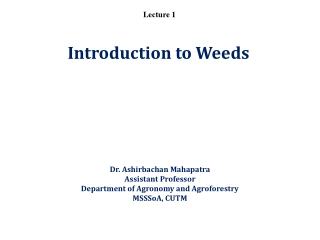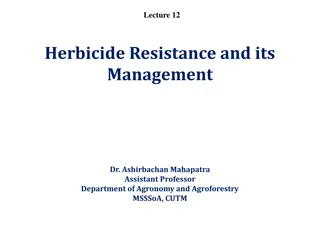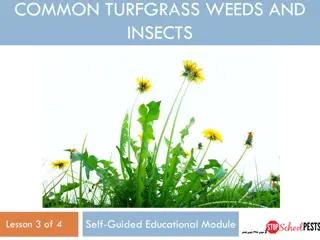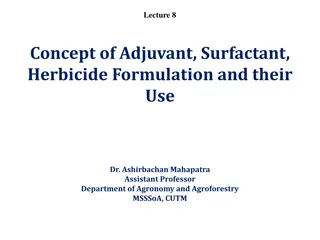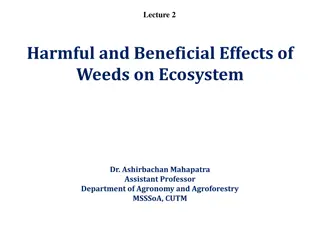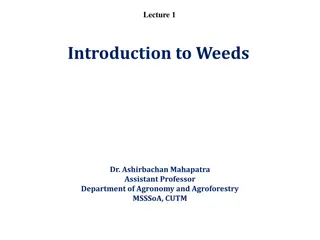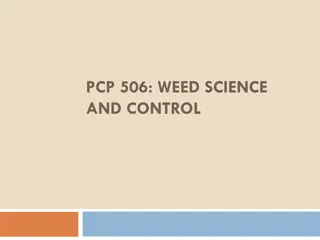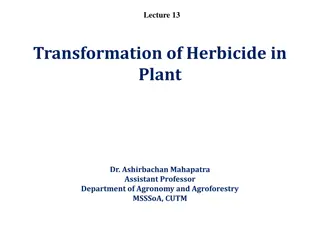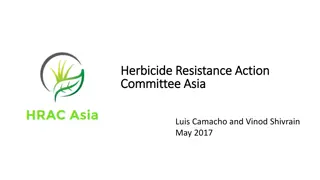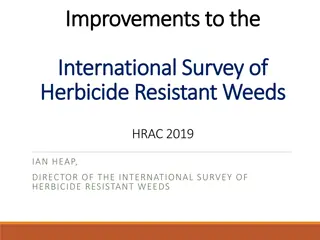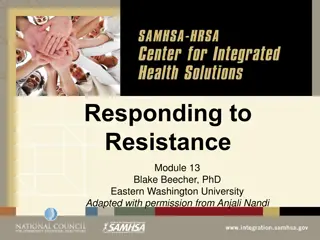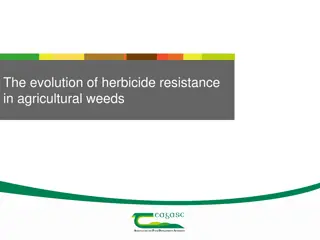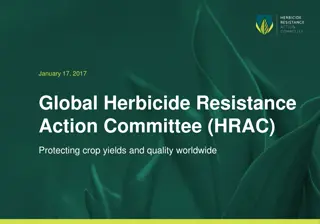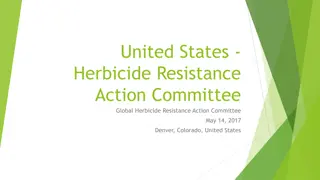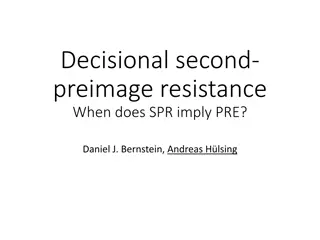Understanding Herbicide Resistance in Weeds: Insights and Management Strategies
Herbicide resistance is a naturally occurring phenomenon in weed populations, impacting the effectiveness of herbicide treatments. This resistance can be passed down through generations and is influenced by various factors such as cultural practices, herbicide mechanisms, and the biology of weed species. Different mechanisms of resistance affect the speed of selection, with exclusionary resistance evolving more slowly compared to target site resistance.
Download Presentation

Please find below an Image/Link to download the presentation.
The content on the website is provided AS IS for your information and personal use only. It may not be sold, licensed, or shared on other websites without obtaining consent from the author. Download presentation by click this link. If you encounter any issues during the download, it is possible that the publisher has removed the file from their server.
E N D
Presentation Transcript
Lecture 12 Herbicide Resistance and its Management Dr. Ashirbachan Mahapatra Assistant Professor Department of Agronomy and Agroforestry MSSSoA, CUTM
Herbicide Resistance: Naturally occurring inheritable ability of some weed biotypes within a population to survive a herbicide treatment that would, under conditions of use, effectively control the weed population (Rubin, 1991). Herbicide resistance can be defined as the acquired ability of a weed population to survive a herbicide application that previously was known to control the population. Herbicide Tolerance: Herbicide tolerance is the inherent ability of a species to survive and reproduce after herbicide treatment. There has been no selection acting on the tolerant weed species, and there has been no change in the weed species lack of response to the herbicide over time. The term tolerance refers to the partial resistance and presently the usage of the term is discouraged due to inconsistency in quantifying the degree of tolerance.
Senecio vulgaris resistance to triazine group of herbicide was noticed during 1970 Worldwide 183 weeds have developed resistance to herbicides till 1997 In India the most common example is Phalaris minor The highest resistance in 61 weed species was recorded for atrazine USA alone found to have 49 herbicide resistant weeds, the highest in the world Herbicide Resistance: Basic Principles Herbicide resistance is the result of naturally occurring processes. Herbicide resistant individuals biotypes* are present naturally within the weed population at very low frequencies. These individuals have a herbicide resistance mechanism that allows them to survive the application of a herbicide. Weed control failures do automatically mean that the weeds are herbicide resistant. Senecio vulgaris or In general, weed populations are genetically diverse, and individual plants within a species can respond differently to the same herbicide rate. This does not mean, in all cases, that the least sensitive individuals are herbicide resistant, but it is a possibility. Herbicide rates are initially established to be effective on the vast majority of the individuals in a population under normal growing conditions. This is why using labeled rates is important. not Resistance is heritable. It can be passed from one generation to the next.
Factors Affecting Speed of Selection The length of time for selection of resistance varies by: Cultural practices Frequency of herbicide use Herbicide mechanism of action Year 0 Year 2 Year 4 Year 6 Year 8 Year 10 Later Biology of weed species Frequency of resistant biotypes among weed species Another factor affecting the speed of selection is the mechanism of herbicide resistance. There are two general types of mechanisms: (1) Exclusionary resistance (for example, differential uptake and translocation, compartmentalization and metabolic detoxification) and (2) Target site resistance (alteration of the targeted enzyme and overproduction of a specific enzyme). Exclusionary resistance generally takes longer to evolve in the field.
Level of Herbicide Resistance The level of herbicide resistance in weeds varies by weed biology and resistance mechanism. In some cases, resistance occurs when the species survives application of a labeled rate, while in other cases, the species can survive up to 1000 times the labeled rate. (1X equals the labeled rate.) This is important in terms of being able to identify herbicide resistance in the field. Herbicide Resistance Characteristics High Level Resistance Plants are slightly injured to uninjured Low Level Resistance A continuum of plant responses from slightly injured to nearly dead The majority of plants display an intermediate response Susceptible plants will be present in the population, especially when herbicide resistance is determined early Few plants have an intermediate responses Susceptible plants can be present in the population
Types of Herbicide Resistance Single Herbicide Resistance Resistant to only one herbicide Cross Herbicide Resistance Resistant to two or more herbicide families with same mechanism of action Single resistance mechanism Multiple Herbicide Resistance Resistant to two or more herbicides with different mechanisms of action May be the result of two or more different resistance mechanisms
Herbicide Resistance Types: Cross Resistance An example with common ragweed Classic, a sulfonylurea, and FirstRate, a triazolopyrimidine, both belong to the ALS inhibitors, or group 2 herbicides. Both herbicide products have the same mechanism of action. CAUTION: Weeds that are herbicide resistant to one member of a herbicide mechanism of action group may or may not be cross resistant to all herbicides within that group. Consult your local extension specialist for more information.
Herbicide Resistance Types: Multiple Resistance Multiple resistance can occur following repeated applications of a single herbicide and selection for herbicide resistant biotypes followed by repeated applications of another herbicide and selection for herbicide resistant biotypes.
Basic principles of herbicide resistance 1. Time, dose and method of application of herbicide variation 2. Variation in phenotypes of a population 3. Genetic variation by mutation or activation of pre existing genes Conditions favourable for development of Herbicide resistance 1. Repeated use of same herbicide or use of herbicide with same mode of action due to the practices of monoculture 2. Areas where minimum/zero tillage is followed 3. Fields where farmers rely on only herbicides for high degree/level of weed control including nurseries, orchards 4. Non-crop situations like road sides, railway tracks etc. where herbicides are repeated used may be at higher doses than cropped situation
Resistance was exhibited in crop is due to 1. Herbicide metabolism by crops making them inactive 2. Absence of certain metabolic process in crops compared to weeds and thus tolerating the herbicides 3. Crops couples the herbicide molecule Antidotes: Chemicals which are used to inactivate the applied herbicides are called as antidotes. Eg. Paraquat spray can be inactivated by spraying 1% ferric chloride Safeners / protectants: Substances used for protecting crop plants, which are otherwise susceptible or less tolerant to some herbicides at doses required for good weed control. eg., Naphthalic anhydride (NA) 0.5 g/kg of seed for rice to protect against molinate and alachlor; R 27788 soil application protects maize from alachlor and metolachlor
Herbicide resistance probably develops through the selection of naturally occurring biotypes of weeds exposed to a particular family of herbicides over a period of years. A biotype is a population of plants within the same species that has specific traits in common. Resistant plants survive, go to seed, and create new generations of herbicide resistant weeds. Mechanisms for resistance vary depending on herbicide family. Resistant biotypes may have slight biochemical differences from their susceptible counterparts that eliminates sensitivity to certain herbicides. Also, while photosynthesis is inhibited in triazine herbicide susceptible biotypes, because of a slight change in a chloroplast protein, triazine resistant biotypes are able to continue normal photosynthesis upon exposure to triazine herbicides. The potential for developing herbicide resistant biotypes is greatest when a herbicide has a single site of action. Regardless of the mechanism for resistance, becoming familiar with the herbicide mode of action can help design programs that prevent the introduction and spread of herbicide resistant weeds. Management programs for herbicide resistance should emphasize an integrated approach that stresses prevention. Dependence on a single strategy or herbicide family for managing weeds will surely increase the likelihood of additional herbicide resistance problems in the future.
Strategies for preventing or managing herbicide resistance Practice crop rotation. Rotate herbicide families and use herbicides with different modes of action. Use herbicide mixtures with different modes of action. Control weedy escapes and practice good sanitation to prevent the spread of resistant weeds. Integrate cultural, mechanical, and chemical weed control methods. Effect of sub lethal dosage When herbicides are applied on the soil, neighboring fields may be affected by drift. The high doses of herbicides applied to previous crop may be harmful to the succeeding crop. However, these sub lethal doses may be occasionally helpful based on crop and the herbicide used. Herbicides show stimulatory effects on crops and toxic effects on sensitive crops even at sub lethal doses. Which show stimulatory effects are phenoxys, triazines, ureas and uracils. In fact, 2, 4-D was first used for its hormonal effect before its herbicidal properties were discovered.
Phenoxy herbicides have growth promoting activities at lower doses similar to indolacetic acid (IAA). They are active at the meristamatic tissues causing increased metabolic activities and cosequently higher grain protein content and yield. Protein content of wheat is increased by dusting 5g/ha of 2,4-D mixed with micronutrients like iron and copper. Even higher dose, say 0.5 to 1.3 kg/ha applied to the soil as herbicide before sowing increases the protein content of wheat. The other crops which show stimulatory effect due to herbicide application are beans, potato, sugarcane, soybean etc. Among triazines, simazine and atrazine produce favourable effects at sub lethal doses. They increase nutrient absorption, chlorophyll and protein content. Simazine at 0.06 ppm increased nutrient uptake and yield of maize, but at 0.30 ppm concentration the yield decreased. The sub lethal effects caused by drifts are rarely toxic except to sensitive crops. Spray drift of 2,4 D causes epinasty on cotton plants. Amitrole at 10 to 100 ppm sprayed on tobacco or wheat causes chlorosis due to chloroplast malformation and reduction in chlorophyll and carotenoids. Soil residues of herbicides appilied to the previous crops may affect germination of sensitive crops.


